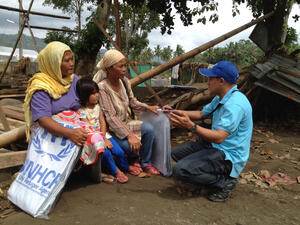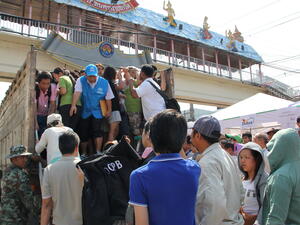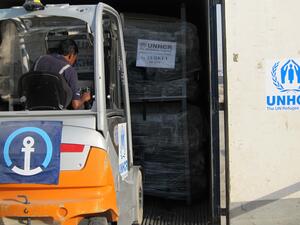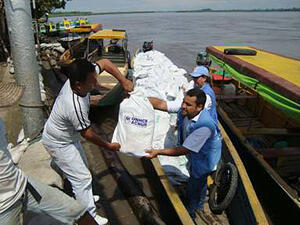Looking beyond emergency relief in Aceh
Looking beyond emergency relief in Aceh

Shelters in Aceh will need to cater to the special needs of women and children, says UNHCR.
LAMNO, Indonesia, Jan 28 (UNHCR) - Naryudin, a young Indonesian army recruit, was sitting in his watch tower on a hill on the coast of Lamno, Aceh, on December 26 last year. "I heard a big bang, the water under me turned black and then it started to cook, big, big bubbles everywhere. Then a wave came, so big I had never seen in my life."
"I sat and stared and with the first wave, all I had been guarding beneath me was gone. The wave ebbed far into the sea and I saw fish jumping up and down on the bare sand. Then an even bigger wave crashed into Lamno town, breaking palm trees like matchsticks. When the third wave left, all was gone, even the hill behind me. It was just me and my colleague. I sat for two days in my tower before someone came to save me. I had just seen the world disappear in front of my eyes."
A month ago, the world woke up to the incredible devastation caused by a massive earthquake and the ensuing tsunamis that destroyed large parts of coastlines in the Indian Ocean. The world reacted en masse and UNHCR teams - in an unprecedented decision to take an active role in relief for natural disasters - were dispatched all over Asia to help.
"The first UNHCR staff arrived in Aceh on January 2, followed quickly by additional staff," said Robert Ashe, UNHCR's Representative in Jakarta. "Those initial days were spent assessing the extent of the disaster's impact and trying to meet the immediate needs of the survivors. At the same time, plans were made for a longer-term response."
Today, more than a month after the tsunami hit, UNHCR has established field presence on the western coast of Aceh on Indonesia's Sumatra island - in Meulaboh, Calang and Lamno - and is covering Krueng Sabe and Keude Panga out of Calang. The last three villages have been totally destroyed. In Calang, where only 10 percent of the population survived, UNHCR staff live and work from two tents based in the devastated town. In the coming weeks, additional teams will also be sent to Teunom and Lhong.
"Relief supplies such as tents, blankets and plastic sheeting have been dispatched and/or distributed to some 30,000 people in Lamno, Meulaboh and Calang, including the remote village of Krueng Sabe where 50 percent of the population died," said Alan Vernon, who heads UNHCR's emergency operation in Aceh.
He added, "UNHCR provided CARE with non-food items for distribution to some 12,000 displaced persons in Simeulue Island. In Banda Aceh, we worked with French fire-fighting group Sapeurs-Pompiers to deliver tents in spontaneous sites for displaced people in situations of extreme need. In Sigli, MSF [Médecins Sans Frontières (Doctors Without Borders)] will distribute UNHCR non-food items for 2,500 families. There are several examples like this and we will continue to distribute emergency relief, if and where needs arise."
In Meulaboh, after witnessing the crowded conditions in the relocation sites, UNHCR negotiated with the government to set up a model camp which would initially accommodate 500 people but could be expanded later to house an additional over-200. UNHCR's site planners advised on the development of the site and NGO Oxfam was invited to set up the water and sanitation facilities there. UNHCR will also implement a pilot project with Catholic Relief Services to distribute plastic sheets, rope and shelter tool kits to 100 families in the coastal area of Meureubo, enabling them to build their own shelter.
"While we recognise and support the immediate needs, we have from the start wanted to focus on longer-term solutions," said UNHCR's Vernon. "We have been involved in policy development and the drafting of guiding principles for internally displaced persons. At the same time, we have put our shelter experts on the case."
Over the past weeks, two UNHCR shelter experts and site planners have been advising the Indonesian Public Works Department on how to improve the design of the semi-permanent shelters planned to meet the needs of up to 150,000 of those displaced in Aceh.
"We discussed the design of sites on the basis of protection-based physical planning principles," said Ghassem Fardanesh, UNHCR's shelter specialist. "What we suggested was a more family-friendly design, one that better responds to the needs of women and children, improves the location of latrines and kitchens, and enhances the community's capacity for self-protection and security. The response to our suggestions has been very positive and the suggestions will be included in the shelter design."
UNHCR has also agreed in principle with the government on the implementation of a pilot project supporting early recovery and reconstruction of the homes of 1,000 families in heavily-destroyed Krueng Sabe.
The refugee agency's role goes beyond shelter and non-food relief items. Earlier this month, its health specialist joined the World Health Organization to lead health assessments in Aceh province, and provided several recommendations on the overall health response. UNHCR supported the measles vaccination campaign with the provision of two vehicles, gave inputs to the guidelines on separated children and on psycho-social support in the post-tsunami context, and provided technical advice on water and sanitation issues.
In meetings with the Women's Empowerment Bureau, UNHCR agreed to consider supporting two national staff members who will work with the Bureau - one to focus on gender and legal rights of women, and another to look at gender and community participatory processes.
"What we want is to provide support that will improve life in the longer term, not only with adequate shelter, but also with improvements in all aspects of their lives and communities," said Vernon. 'In one month we got a lot done, but there is still a long road to go. No one can rebuild overnight what the tsunami destroyed in a matter of only a few minutes."
There was a bang, there were bubbles and then three waves. How simple it sounds. But how extremely difficult to reconstruct the broken lives and livelihoods left behind.
By Astrid van Genderen Stort in Lamno, Indonesia







